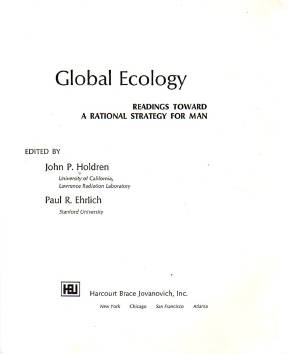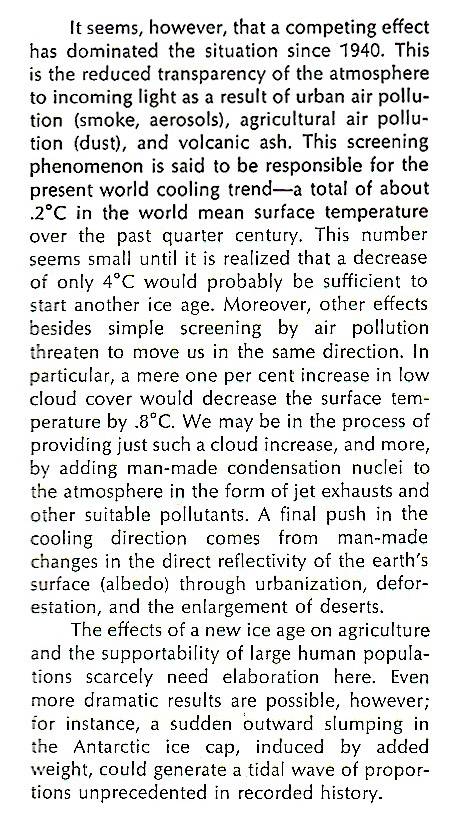 |
In 1971, John Holdren edited and contributed an essay to a book entitled Global Ecology: Readings Toward a Rational Strategy for Man. He wrote (along with colleague Paul Ehrlich) the book’s sixth chapter, called “Overpopulation and the Potential for Ecocide.” (Click here to view a photograph of the table of contents, showing Holdren’s essay on pages 64-78; click on the image to the left to view the cover.) In their chapter, Holdren and Ehrlich speculate about various environmental catastrophes, and on pages 76 and 77 Holdren the climate scientist speaks about the probable likelihood of a “new ice age” caused by human activity (air pollution, dust from farming, jet exhaust, desertification, etc.).
Below is a direct scan from pages 76-77 in the book Global Ecology, with an exact transcription on the right.
(Following this section, scroll down to see the extended passage from which this quote was taken, with more context and more discussion.)
John Holdren is now not only the “Science Czar” for the United States, but he’s also one of the original leaders of the “alarmist” wing of the Global Warming debate — and he now promotes the notion that the current climate data points to a looming planetary overheating catastrophe of unimaginable dimensions. (He helped make the charts and graphs for Al Gore’s film An Inconvenient Truth, for example.)
My personal opinion is that Holdren is a “doom peddler” who latches onto the nightmare-scenario-du-jour — overpopulation, nuclear holocaust, global cooling, global warming (all of which he’s trumpeted at various points in his career) — and then wildly exaggerates it in order to scare the public into adopting his politicized “solutions.”
But I’ll let you read the following quote and decide for yourself how you feel about John Holdren’s predictions. (And make sure to read the extended passage below, for more insight.)

|
It seems, however, that a competing effect has dominated the situation since 1940. This is the reduced transparency of the atmosphere to incoming light as a result of urban air pollution (smoke, aerosols), agricultural air pollution (dust), and volcanic ash. This screening phenomenon is said to be responsible for the present world cooling trend—a total of about .2°C in the world mean surface temperature over the past quarter century. This number seems small until it is realized that a decrease of only 4°C would probably be sufficient to start another ice age. Moreover, other effects besides simple screening by air pollution threaten to move us in the same direction. In particular, a mere one percent increase in low cloud cover would decrease the surface temperature by .8°C. We may be in the process of providing just such a cloud increase, and more, by adding man-made condensation nuclei to the atmosphere in the form of jet exhausts and other suitable pollutants. A final push in the cooling direction comes from man-made changes in the direct reflectivity of the earth’s surface (albedo) through urbanization, deforestation, and the enlargement of deserts. The effects of a new ice age on agriculture and the supportability of large human populations scarcely need elaboration here. Even more dramatic results are possible, however; for instance, a sudden outward slumping in the Antarctic ice cap, induced by added weight, could generate a tidal wave of proportions unprecedented in recorded history. |
It’s interesting to note that as recently as 2009, Holdren proposed combining his two disaster scenarios by suggesting we purposely inject pollutants into the upper atmosphere, using the global cooling effects of pollution to cancel out the global warming effects of pollution. (Though he backpedaled after claiming that the media misconstrued his recommendation.)
To be fair, as the following extended passage shows, Holdren predicted that the ice age was going to be only a “short-term threat,” and that global warming (as opposed to cooling) would eventually doom us all in the end, if the ice age hadn’t already finished us off. But, incredibly, after discussing the by-then well-known “greenhouse effect,” Holdren sets that concept aside and instead predicts that the coming global overheating will be caused not by the greenhouse gas carbon dioxide but instead simply by human-caused excess heat generation. As he puts it, “the remaining major means of interference with the global heat balance is the release of energy from fossil and nuclear fuels. As pointed out previously, all this energy is ultimately degraded to heat. What are today scattered local effects of its disposition will in time, with the continued growth of population and energy consumption, give way to global warming.” In other words, it’s not the greenhouse effect that will get us in the long run, but merely energy generation itself as a concept; even nuclear energy, which produces no greenhouse gases, is bad because it produces energy which inevitably becomes heat.
Read the full passage below and come to your own conclusions about Holdren’s track record for predicting the fate of planet Earth.
Pages 76-77 of Global Ecology

|
Substantial interference by man with any part of this process can result in changing the average surface temperature and atmospheric circulation pattern. Such interference currently takes several forms. One is the steady increase of the carbon dioxide content of the atmosphere, believed to be due primarily to increasing combustion of hydrocarbon fuels. Carbon dioxide is essentially transparent to incoming visible light, so it doesn’t change the input to the heat balance; but being opaque to part of the outbound infrared energy, it does reduce the amount of heat which can escape. This effect, if it were the only one operating, would result in a warming trend. (Glass has similar properties which account for the warmth of a greenhouse—and for the name “greenhouse effect” applied to the CO2 phenomenon.) It seems, however, that a competing effect has dominated the situation since 1940. This is the reduced transparency of the atmosphere to incoming light as a result of urban air pollution (smoke, aerosols), agricultural air pollution (dust), and volcanic ash. This screening phenomenon is said to be responsible for the present world cooling trend—a total of about .2°C in the world mean surface temperature over the past quarter century. This number seems small until it is realized that a decrease of only 4°C would probably be sufficient to start another ice age. Moreover, other effects besides simple screening by air pollution threaten to move us in the same direction. In particular, a mere one percent increase in low cloud cover would decrease the surface temperature by .8°C. We may be in the process of providing just such a cloud increase, and more, by adding man-made condensation nuclei to the atmosphere in the form of jet exhausts and other suitable pollutants. A final push in the cooling direction comes from man-made changes in the direct reflectivity of the earth’s surface (albedo) through urbanization, deforestation, and the enlargement of deserts. The effects of a new ice age on agriculture and the supportability of large human populations scarcely need elaboration here. Even more dramatic results are possible, however; for instance, a sudden outward slumping in the Antarctic ice cap, induced by added weight, could generate a tidal wave of proportions unprecedented in recorded history. If man survives the comparatively short-term threat of making the planet too cold, there is every indication he is quite capable of making it too warm not long thereafter. For the remaining major means of interference with the global heat balance is the release of energy from fossil and nuclear fuels. As pointed out previously, all this energy is ultimately degraded to heat. What are today scattered local effects of its disposition will in time, with the continued growth of population and energy consumption, give way to global warming. The present rate of increase in energy use, if continued, will bring us in about a century to the point where our heat input could have drastic global consequences. Again, the exact form such consequences might take is unknown; the melting of the icecaps with a concomitant 150 foot increase in seas level might be one of them. |

101 Responses to “John Holdren in 1971: “New ice age” likely”